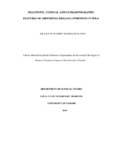| dc.description.abstract | Diagnostic imaging modalities such as radiography, ultrasonography, fluoroscopy,
scintigraphy, magnetic resonance imaging and computed tomography have been used in
veterinary practice. Ultrasound is a non-invasive imaging modality which uses high
frequency sound waves to facilitate visualization of the internal architecture of
parenchymatous and viscous organs. Its major advantages over other imaging
techniques include the fact that, it is safe, non invasive, cost effective and easy to perform. Reports and scientific literature on the ultrasonographic evaluation of
abdominal disease conditions in dogs in Kenya are scanty. Data on these aspects of
diagnostic, clinical and ultrasonographic features of abdominal disease conditions
remain limited and thus the information from this study could help in the diagnosis of
abdominal disease.
The aim of this study was to enhance the use of ultrasonography as a diagnostic tool in the effective management of abdominal disease conditions in dogs presented at the
Small Animal Clinic, University of Nairobi, Kenya (2011-2013). The objectives were to
relate the clinical features of abdominal conditions and their ultrasound findings; to
compare the ultrasonographic appearance of abdominal organs in normal and diseased
dogs; and to determine a confirmatory diagnosis using ultrasound supported by other
ancillary tests. These tests included: radiography, haematology and clinical chemistry,
abdominal fluid analysis, exploratory laparotomy, post-mortem and histopathological
examination.
Organs that were selected for ultrasound scanning included: the liver, spleen, stomach,
intestines, uterus in bitches, right and left kidneys and the urinary bladder. The acoustic
window used to scan the uterus was the urinary bladder through the ventral midline
body wall. All organs were scanned trans-cutaneously based on their corresponding
anatomic locations.
Thirty clinically normal dogs were scanned to serve as a control group and reference for
normal tissue appearances. Dogs were evaluated by physical examination and
categorized according to body weight and breed types. Investigation comprised twenty
five purposively selected dogs which fulfilled the criteria of exhibiting clinical signs of abdominal disease. The abdominal organs of dogs were scanned with the organ of interest beings elected as the organ whose pathology had led to the clinical signs
exhibited.
The following measurements were recorded for analysis: right kidney horizontal
diameters (Rkh), right kidney vertical diameter (Rkv), left kidney horizontal diameters
(Lkh), left kidney vertical diameter (Lkv), the stomach wall thickness (Sw) and
intestinal wall thickness (Sit). Data was analysed quantitatively using the independent test to compare breed types and age groups. The study findings revealed at 95% confidence interval, a significant difference in the left kidney horizontal diameter (Lkh) of
large breeds (p=0.02) when compared to the right kidney horizontal diameter (Rkh). The p
values of the other measurements showed no significant difference (p>0.05) between
both breed types and age groups.
The sonograms were descriptively evaluated based on changes in echotexture. The
control group sonograms were compared with the research group‘s sonograms. It was found that the echo texture of the organ sex hibiting pathologies was detectable on ultrasound and the changes varied from mild to severe. The ultrasound findings were related to the
clinical features exhibited in the dogs diagnosed with the various abdominal conditions.
These included liver cirrhosis, urinary bladder calculi, splenic hemangiosarcoma and
pyometra.
Results showed that the liver was viewed with best clarity compared to other organs due
to its location and size. The right kidney was often not visualized due to obstruction by
air in the overlapping thoracic cavity. The stomach was best visualized when filled with
fluid. The urinary bladder was used as an acoustic window to view abdominal organs
due to acoustic enhancement property of fluid such as urine. The uterus was visualized
only when it was filled with contents such as when it contained pus or foetal parts. The
spleen was best visualized on the left caudal border of the last rib. The intestines were
not well visualized due to reverberation artefacts due to gas accumulation in the
intestinal tract.
Challenges recorded during the study were numerous artefacts seen in the sonograms
such as pseudo sludge, reverberation, acoustic enhancement, clean and dirty acoustic
shadows. Knowledge of the artefacts and proper ways to compensate for these helped in
preventing misdiagnosis.
It was concluded that, whilst the use of ultrasonography has its challenges in the diagnosis of abdominal disease conditions, conditions such as liver cirrhosis and
pyometra were easily identified. Prognosis was reached based on pathologic changes in
echotexture and other ancillary tests. This varied from case to case.
It was noted that ultrasound proved to be a good diagnostic imaging tool for abdominal
disease conditions. Routine ultra sonography is proposed to be a beneficial procedure for the
prompt, cost effective and non-invasive diagnostic procedure of abdominal disease
conditions in dogs | en_US |

